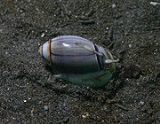
Olivellidae
Encyclopedia
Olivellidae, common name
the "dwarf olives", are a family
of small predatory sea snail
s with smooth, shiny, elongated oval-shaped shells. The shells sometimes show muted but attractive colors, and may have some patterning.
These animals are marine
gastropod molluscs in the superfamily Olivoidea
, within the clade Neogastropoda
according to the taxonomy of Bouchet and Rocroi
.
According to the taxonomy of the Gastropoda by Bouchet & Rocroi (2005)
the family Olivellidae has no subfamilies.
s intertidally and subtidally.
. Olivella shells have a siphonal notch at the posterior end of the long narrow aperture
. The siphon of the living animal protrudes from the siphon notch.
The shell surface is extremely glossy because in life the mantle
almost always covers the shell.
Common name
A common name of a taxon or organism is a name in general use within a community; it is often contrasted with the scientific name for the same organism...
the "dwarf olives", are a family
Family (biology)
In biological classification, family is* a taxonomic rank. Other well-known ranks are life, domain, kingdom, phylum, class, order, genus, and species, with family fitting between order and genus. As for the other well-known ranks, there is the option of an immediately lower rank, indicated by the...
of small predatory sea snail
Snail
Snail is a common name applied to most of the members of the molluscan class Gastropoda that have coiled shells in the adult stage. When the word is used in its most general sense, it includes sea snails, land snails and freshwater snails. The word snail without any qualifier is however more often...
s with smooth, shiny, elongated oval-shaped shells. The shells sometimes show muted but attractive colors, and may have some patterning.
These animals are marine
Marine (ocean)
Marine is an umbrella term. As an adjective it is usually applicable to things relating to the sea or ocean, such as marine biology, marine ecology and marine geology...
gastropod molluscs in the superfamily Olivoidea
Olivoidea
Olivoidea is a taxonomic superfamily of minute to medium-large predatory sea snails, marine gastropod mollusks in the clade Neogastropoda.-Taxonomy:...
, within the clade Neogastropoda
Neogastropoda
Neogastropoda is an unranked taxonomic clade of sea snails, marine gastropod mollusks. For many years prior to 2005 Neogastropoda was an order.- Description :...
according to the taxonomy of Bouchet and Rocroi
Taxonomy of the Gastropoda (Bouchet & Rocroi, 2005)
The taxonomy of the Gastropoda as it was revised by Philippe Bouchet and Jean-Pierre Rocroi is currently the most up-to-date overall system for classifying gastropod mollusks...
.
Taxonomy
This group were previously placed within the family Olividae, the olives.According to the taxonomy of the Gastropoda by Bouchet & Rocroi (2005)
Taxonomy of the Gastropoda (Bouchet & Rocroi, 2005)
The taxonomy of the Gastropoda as it was revised by Philippe Bouchet and Jean-Pierre Rocroi is currently the most up-to-date overall system for classifying gastropod mollusks...
the family Olivellidae has no subfamilies.
Distribution
Olivella snails are found worldwide, in subtropical and tropical seas and oceans.Habitat
These snails are found on sandy substrateSubstrate (marine biology)
Stream substrate is the material that rests at the bottom of a stream. There are several classification guides. One is:*Mud – silt and clay.*Sand – Particles between 0.06 and 2 mm in diameter.*Granule – Between 2 and 4 mm in diameter....
s intertidally and subtidally.
Shell description
The shells are basically oval and cylindrical in shape. They have a well-developed stepped spireSpire (mollusc)
A spire is a descriptive term for part of the coiled shell of mollusks. The word is a convenient aid in describing shells, but it does not refer to a very precise part of shell anatomy: the spire consists of all of the whorls except for the body whorl...
. Olivella shells have a siphonal notch at the posterior end of the long narrow aperture
Aperture (mollusc)
The aperture is an opening in certain kinds of mollusc shells: it is the main opening of the shell, where part of the body of the animal emerges for locomotion, feeding, etc....
. The siphon of the living animal protrudes from the siphon notch.
The shell surface is extremely glossy because in life the mantle
Mantle (mollusc)
The mantle is a significant part of the anatomy of molluscs: it is the dorsal body wall which covers the visceral mass and usually protrudes in the form of flaps well beyond the visceral mass itself.In many, but by no means all, species of molluscs, the epidermis of the mantle secretes...
almost always covers the shell.

